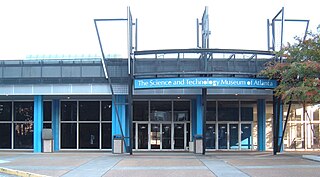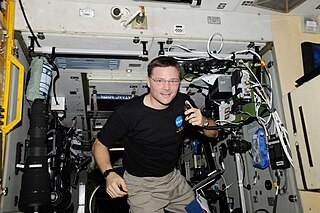Related Research Articles

Space weather is a branch of space physics and aeronomy, or heliophysics, concerned with the time varying conditions within the Solar System, including the solar wind, emphasizing the space surrounding the Earth, including conditions in the magnetosphere, ionosphere, thermosphere, and exosphere. Space weather is distinct from, but conceptually related to, the terrestrial weather of the atmosphere of Earth. The term "space weather" was first used in the 1950s and came into common usage in the 1990s. Later, it was generalized to a "space climate" research discipline, which focuses on general behaviors of longer and larger-scale variabilities and effects.

A geomagnetic storm, also known as a magnetic storm, is a temporary disturbance of the Earth's magnetosphere caused by a solar wind shock wave and/or cloud of magnetic field that interacts with the Earth's magnetic field.

A weather station is a facility, either on land or sea, with instruments and equipment for measuring atmospheric conditions to provide information for weather forecasts and to study the weather and climate. The measurements taken include temperature, atmospheric pressure, humidity, wind speed, wind direction, and precipitation amounts. Wind measurements are taken with as few other obstructions as possible, while temperature and humidity measurements are kept free from direct solar radiation, or insolation. Manual observations are taken at least once daily, while automated measurements are taken at least once an hour. Weather conditions out at sea are taken by ships and buoys, which measure slightly different meteorological quantities such as sea surface temperature (SST), wave height, and wave period. Drifting weather buoys outnumber their moored versions by a significant amount.

The American Association of Variable Star Observers (AAVSO) is an international nonprofit organization. Founded in 1911, the organization focuses on coordinating, analyzing, publishing, and archiving variable star observations made largely by amateur astronomers. The AAVSO creates records that establish light curves depicting the variation in brightness of a star over time. The AAVSO makes these records available to professional astronomers, researchers, and educators.

High-altitude balloons or stratostats are usually uncrewed balloons typically filled with helium or hydrogen and released into the stratosphere, generally attaining between 18 and 37 km above sea level. In 2013, a balloon named BS 13-08 reached a record altitude of 53.7 km.
Computational science, also known as scientific computing, technical computing or scientific computation (SC), is a division of science that uses advanced computing capabilities to understand and solve complex physical problems. This includes

The Science & Technology Museum of Atlanta, usually known as SciTrek, was located at 395 Piedmont Avenue in Atlanta, Georgia, next to the Atlanta Civic Center. It was forced to close in August 2004 due to reduced federal and state funding. All of its displays were sold or auctioned on January 15, 2005. Some of the assets, such as the Challenger Learning Center, were transferred to Fernbank Science Center, also in Atlanta.

Citizen science is scientific research conducted with participation from the general public. There are variations in the exact definition of citizen science, with different individuals and organizations having their own specific interpretations of what citizen science encompasses. Citizen science is used in a wide range of areas of study, with most citizen science research publications being in the fields of biology and conservation. There are different applications and functions of citizen science in research projects. Citizen science can be used as a methodology where public volunteers help in collecting and classifying data, improving the scientific community's capacity. Citizen science can also involve more direct involvement from the public, with communities initiating projects researching environment and health hazards in their own communities. Participation in citizen science projects also educates the public about the scientific process and increases awareness about different topics. Some schools have students participate in citizen science projects for this purpose as a part of the teaching curriculums.

The Milton J. Rubenstein Museum of Science and Technology is a science and technology museum located in the Armory Square neighborhood of Downtown Syracuse, New York. The Museum includes 35,000 square feet of permanent and traveling exhibits, Science Shop, and several programs and events. The MOST is located in the former Syracuse Armory.

An amateur radio operator is someone who uses equipment at an amateur radio station to engage in two-way personal communications with other amateur operators on radio frequencies assigned to the amateur radio service. Amateur radio operators have been granted an amateur radio license by a governmental regulatory authority after passing an examination on applicable regulations, electronics, radio theory, and radio operation. As a component of their license, amateur radio operators are assigned a call sign that they use to identify themselves during communication. About three million amateur radio operators are currently active worldwide.

In meteorology and climatology, a mesonet, portmanteau of mesoscale network, is a network of automated weather and, often also including environmental monitoring stations, designed to observe mesoscale meteorological phenomena and/or microclimates.

Amateur radio, also known as ham radio, is the use of the radio frequency spectrum for purposes of non-commercial exchange of messages, wireless experimentation, self-training, private recreation, radiosport, contesting, and emergency communications. The term "amateur" is used to specify "a duly authorized person interested in radioelectric practice with a purely personal aim and without pecuniary interest"; and to differentiate it from commercial broadcasting, public safety, or professional two-way radio services.

Environmental volunteers conduct a range of activities including environmental monitoring ; ecological restoration such as revegetation and weed removal, and educating others about the natural environment. They also participate in community based projects, improving footpaths, open spaces, and local amenities for the benefit of the local community and visitors. The uptake of environmental volunteering stems in part from the benefits for the volunteers themselves, such as improving social networks and developing a sense of place.

Colorado Student Space Weather Experiment (CSSWE) was the sixth National Science Foundation sponsored CubeSat mission. It was built by students at the University of Colorado at Boulder with advising from professionals at the Laboratory for Atmospheric and Space Physics. The CSSWE mission was a joint effort by the University of Colorado's Department of Aerospace Engineering Sciences and Laboratory for Atmospheric and Space Physics. The mission principal investigator was Prof. Xinlin Li, and the Co-PIs are Prof. Scott Palo and Dr. Shri Kanekal. The project manager for the project was Dr. Lauren Blum, the system engineer was Dr. David Gerhardt, and the instrument scientist was Dr. Quintin Schiller.

Neal Pollock is a Canadian academic and diver. Born in Edmonton, Canada he completed a bachelor's degree in zoology; the first three years at University of Alberta and the final year at the University of British Columbia. After completing a master's degree he then served as diving officer at University of British Columbia for almost five years. He then moved to Florida and completed a doctorate in exercise physiology/environmental physiology at Florida State University.

Elizabeth MacDonald is a space weather scientist who works at NASA Goddard Space Flight Center. She is a co-investigator on the Helium, Oxygen, Proton, and Electron Spectrometer on the NASA Radiation Belts Storm Probe mission.
Lin Chambers is an American physical scientist. She has developed and contributed to multiple international programs around science education and citizen science at NASA Langley Research Center.
Tamitha Skov is a space weather physicist, researcher and public speaker based in Los Angeles. She is also referred to as "Space Weather Woman" in social media, where she forecasts and analyzes space weather processes - in the heliosphere and exosphere, in addition to her conducting the same in traditional media. Skov is presently serving as a research scientist at The Aerospace Corporation and as an adjunct professor of heliophysics and space weather at Millerville University.

SpaceX CRS-27, also known as SpX-27, was a Commercial Resupply Service mission to the International Space Station (ISS) launched on 15 March 2023. The mission was contracted by NASA and was flown by SpaceX using Cargo Dragon C209. This was the seventh flight for SpaceX under NASA's CRS Phase 2.

PSK Reporter is an amateur radio signal reporting and spotting network and website started by Philip Gladstone in 2014 which allows operators to see where their radio signals are being received. The platform works by collecting digital signal reports from software clients such as WSJT and FLDIGI, then mapping them to show which stations are being heard by other clients. The website takes its name from the popular amateur radio digital mode PSK31 and supports numerous digital modes, but now the vast majority of digital modes recorded by the service are FT8 traffic. Most traffic recorded on PSK Reporter is in the HF amateur radio bands but the platform also supports MF, VHF, and UHF bands. As of 2021 PSK Reporter had collected over 20 billion reception reports.
References
- ↑ "Ham Radio Forms a Planet-Sized Space Weather Sensor Network". Eos. 9 February 2021. Retrieved 21 March 2021.
- ↑ "HamSCI Workshop 2021: Midlatitude Science | HamSCI". www.hamsci.org. Retrieved 22 March 2021.
- ↑ Frissell, N.; Joshi, D.; Collins, K.; Montare, A.; Kazdan, D.; Gibbons, J.; Mandal, S.; Engelke, W.; Atkison, T.; Kim, H.; Gerrard, A.; Vega, J.; Cowling, S.; McDermott, T.; Ackermann, J.; Witten, D.; Silver, H.; Liles, W.; Cerwin, S.; Erickson, P.; Miller, E.; Miller, E. (2020). "HamSCI Distributed Array of Small Instruments Personal Space Weather Station (DASI-PSWS): Architecture and Current Status (Invited)". www.hamsci.org.